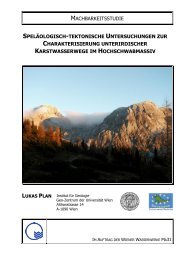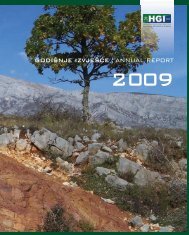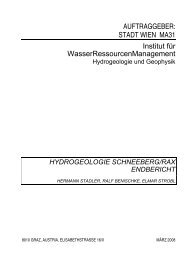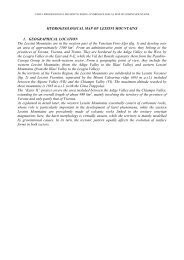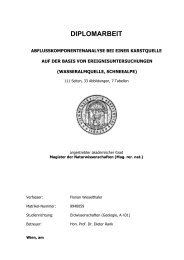Explanatory notes to the digital geological map of the Rax ... - KATER
Explanatory notes to the digital geological map of the Rax ... - KATER
Explanatory notes to the digital geological map of the Rax ... - KATER
You also want an ePaper? Increase the reach of your titles
YUMPU automatically turns print PDFs into web optimized ePapers that Google loves.
<strong>KATER</strong> II Geology <strong>of</strong> <strong>the</strong> <strong>Rax</strong>-Schneeberg-region<br />
__________________________________________________________________________________________<br />
fact <strong>of</strong> immediate interfingering <strong>of</strong> <strong>the</strong> „reef” with lagoonal birdseye limes<strong>to</strong>nes is considered<br />
as a prove for platform-edge reefs and not an upper slope situation. Typical assemblages <strong>of</strong><br />
a deeper water slope (ammonites, radiolarians, silicisponges) are missing. Such biota<br />
occures only in very rare small lenses <strong>of</strong> Hallstatt-type within <strong>the</strong> reef <strong>of</strong> Heukuppe (summit<br />
<strong>of</strong> <strong>Rax</strong>-plateau).<br />
A conspicuous feature <strong>of</strong> platform-edge facies in <strong>the</strong> Wetterstein Limes<strong>to</strong>ne is <strong>the</strong><br />
development <strong>of</strong> coarse breccias. The term „Grossoolite” refers <strong>to</strong> thick, laminated,<br />
isopachous coatings <strong>of</strong> radiaxial-fibrous calcite cement and calcite-replacive dolomite around<br />
lithoclasts and skeletal particles. Although initially interpreted as being <strong>of</strong> organic origin<br />
(“Evinospongia”), <strong>the</strong>se coatings are now regarded as inorganic or microbial initiated<br />
cements. The component clasts are commonly angular and <strong>of</strong>ten poorly sorted, ranging in<br />
size from a few centimeters <strong>to</strong> several decimeters in diameter. They are mainly composed <strong>of</strong><br />
reefal lithologies. In places <strong>the</strong> grossoolitic breccias are <strong>the</strong> only remaining evidence <strong>of</strong> <strong>the</strong><br />
former existence <strong>of</strong> in-situ shelf-margin reefs. Syndepositional tec<strong>to</strong>nism, oversteepening <strong>of</strong><br />
<strong>the</strong> platform margin, slope instability, or a combination <strong>of</strong> <strong>the</strong>se processes must have been<br />
causative fac<strong>to</strong>rs in <strong>the</strong> formation <strong>of</strong> such widespread breccia deposits.<br />
Wetterstein lagoonal facies (66)<br />
Rocks <strong>of</strong> this facies are generally massive <strong>to</strong> thick bedded, locally bioturbated limes<strong>to</strong>nes<br />
with a diverse biota <strong>of</strong> various dasycladacean, solenoporacean and codiacean algae,<br />
molluscs (mainly gastropods), echinoderms, rare framebuilding organisms, brachiopods,<br />
foraminifers and ostracodes. Textures vary from wackes<strong>to</strong>nes <strong>to</strong> grains<strong>to</strong>nes. Patch reefs<br />
inside <strong>the</strong> lagoon are very rare. The immediate transitional area behind <strong>the</strong> reef - <strong>the</strong> nearreef<br />
lagoon - is <strong>of</strong>ten characterized by bounds<strong>to</strong>nes or birdseye-limes<strong>to</strong>nes with mixed biota<br />
consisting <strong>of</strong> reef debris and <strong>the</strong> dasycladacean Teutloporella herculea, which one is <strong>the</strong><br />
dominant algal species in <strong>the</strong> <strong>Rax</strong>-Schneeberg area. In <strong>the</strong> uppermost part <strong>of</strong> <strong>the</strong> lagoon<br />
additionally Poikiloporella duplicata occurs and indicates an Early Carinan age.<br />
Wetterstein dolomite (65)<br />
Parts <strong>of</strong> <strong>the</strong> Wetterstein limes<strong>to</strong>ne have been affected by a secondary dolomitization. In <strong>the</strong><br />
<strong>Rax</strong> and Schneeberg area a local dolomitization <strong>to</strong>ok place mainly within <strong>the</strong> reef and reef<br />
breccia facies. These dolomites form bodies <strong>of</strong> irregular size, which cannot be assigned <strong>to</strong><br />
distinct stratigraphic levels. Prediction <strong>of</strong> <strong>the</strong> extent <strong>of</strong> subsurface dolomite bodies can be<br />
given only schematic – see cross sections.<br />
In <strong>the</strong> Schneealpe <strong>the</strong> dolomitization has affected <strong>the</strong> Wetterstein platform nearly complete.<br />
Also adjacent slope sediments <strong>of</strong> Grafensteig limes<strong>to</strong>ne have been partly dolomitized.<br />
Nor<strong>the</strong>rn Alpine Raibl-Group ( 64) - (61)<br />
The Wetterstein platforms in general show a platform progradation over <strong>the</strong> adjacent basinal<br />
sediments until <strong>the</strong> Earliest Carnian ("Cordevolian"). Then carbonate production decreased<br />
rapidly due <strong>to</strong> a sealevel lowstand. The platforms emerged, <strong>the</strong> remainig basins received<br />
siliciclastics from <strong>the</strong> European hinterland in form <strong>of</strong> marine black shales, <strong>the</strong> Reingraben<br />
shale (64). The shales are interbedded with dark cherty limes<strong>to</strong>nes (63), dolomites (61)<br />
and dark biodetrital limes<strong>to</strong>ne (62), derived from small surviving reef mounds at <strong>the</strong> basin<br />
margins.<br />
10



